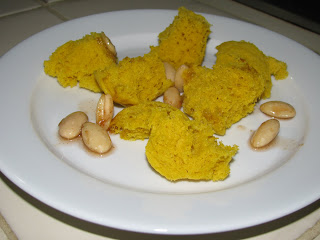Some CSA canistels had been hanging around in my freezer for several weeks now, but I had a plan for them: microwave cakes. This was actually one of the things I hoped to accomplish when I started blogging my CSA shares: to combine fresh-from-the-farm produce with some personal experimentation in contemporary cookery, a small, humble attempt to show that the two are not as antithetical as many people (i.e., those who insist on tags like "science fiction cooking" or use "molecular gastronomy" as an epithet) make them out to be. Well, best laid plans and all ... I've generally been lucky just to get the stuff cooked in the most primitive of fashions, though I've done some good eating along the way.
Anyway, like so many contemporary techniques, the microwave cake's genesis appears to trace back to none other than Ferran Adrià. It uses an iSi whipped cream canister charged with nitrous oxide to aerate the batter (the same tool chefs sometimes use to make those foams so dreaded by some), and is cooked in a single-serve cup in the microwave in 30-40 seconds, making a wonderful light spongey cake. There are a few recipes floating around the intertubes if you search for them, but they vary considerably, so I went to my resident experts - chefs Kurtis Jantz and Chad Galiano - for guidance, who gave me a few recipes and suggestions as starting points.
Not surprisingly, none of the recipes use canistel, so my primary guide was one for a beet cake, figuring pureed beet is about as close as I'd get to canistel. Here's what went into it:[*]
100g almond flour (a little less than a cup) (couldn't find actual almond flour anywhere, simply ground up some blanched unsalted almonds in the food processor)
200g canistel flesh (about a cup)
250g egg whites (about 6 large whites)
160g egg yolks (8 yolks)
100g sugar (about 1/2 cup)
130g flour (about 1 cup) (recipe called for cake flour, I had none, and used all-purpose; no doubt cake flour would have yielded a lighter final product)
Mix all the ingredients in a blender (I suspect a stand mixer would have worked equally well) until smooth, and strain through a chinois. I had to stir it through vigorously with a wooden spoon for about 10 minutes.
Then you break out the high-tech hardware:
The iSi canister, and - that's right: Dora the Explorer paper cups. Trust me, this is exactly how they do it at El Bulli.
Pour the mixture into the iSi canister (not more than 1/2 full, it's marked at .5 liters), then charge the canister with three NO2 chargers (no jokes please about alternative uses). Shake the canister firmly 2-3 times, then chill it for at least a couple hours. When you're ready to serve, poke some holes with a knife in the bottom and sides of a cup (the Dora cups were the only smaller sized - 7 oz. - cups I could find at the grocery store; you will probably be OK using other ones, such as SpongeBob) and fill the cup 1/3 full of the batter. Then microwave for 40 seconds.
Take it out of the microwave, run a knife around the edges to unstick it (careful there is a lot of steam releasing) and dump it out. It will have risen to near the edge of the cup. Here's a before and after:
You'll get a fluffy little single-serving size cake, like so (I got about 12 cakes total from the 1/2 liter batch in the canister):
You could probably trim the wider end of this flat and stand it up, but the modern cheffy thing to do (and it also helps release some of the steam) is to tear this into bite-sized pieces for service. So that's what I did, together with some almonds warmed up in a simple syrup spiked with cinnamon, vanilla powder and a touch of cayenne pepper.
Something like a sabayon would have been nice to echo the eggy flavor of the canistel, but this was just a Sunday afternoon experiment, not really a full-blown dish. The texture was denser and less airy than what I was shooting for, likely the result of the higher-protein, more glutenous all-purpose flour instead of the cake flour, and/or the sticky, dense canistel flesh. This had mostly tiny air bubbles whereas other microwave cakes I've tried have much bigger bubbles (and lighter texture). Less flour would also probably have let the canistel flavor come through even more clearly, though it was still distinct. But this was still nice, with a good flavor and a light, sponge-cake like texture. The cakes got the Frod Jr. / Little Miss F seal of approval, which is always a good sign.
[*]Many chefs using these newer techniques use weight rather than volume for measurements as it's more accurate; it's also a big pain in the ass for home chefs, though I did have fun playing with my digital scale. I've given approximate volume measurements as well.









No comments:
Post a Comment